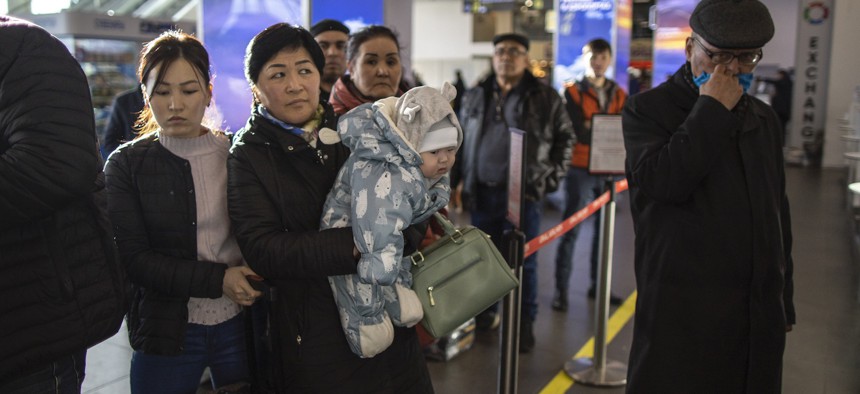
Kyrgyzstan's people queue up to board a plane to Osh, Kyrgyzstan at the Zhukovsky international airport 36 km (22,5 mikes) southeast of Moscow, Russia, Monday, March 23, 2020. AP Photo/Alexander Zemlianichenko
Can Better Airplane Boarding Procedures Slow the Spread of Coronavirus?
A new computer model offers a better way to understand how people move in tight spaces, which can affect how viruses spread.
Could changing the way people move and congregate in cramped places like ships or planes help to curb the spread of COVID-19? Health experts have recommended that people maintain a distance of six feet from strangers in order to avoid contracting the deadly disease. But physical distancing is nearly impossible in some instances, like getting on a plane or being aboard a ship. A group of Florida researchers have developed a computer model to help determine how people move in these very small spaces, which managers can then use to change procedures to limit spread.
On airliners, says Ashok Srinivasan, a University of West Florida professor, aerosolized infections like SARS or COVID-19 tend to have a limited spread: two rows in front and two rows behind the sick passenger. But sometimes one super-spreading passenger can sicken more than half of the plane. More than half of the cases of SARS contracted aboard airplanes occurred this way.
“One might be tempted to look at this outbreak as an outlier. But the ‘outlier' had the most impact,” Srinivasan told the Texas Advanced Computer Center. That’s why modeling how quickly people tend to board planes and ships, and how long they have to stand next to people in close quarters, can help make those processes safer.
In a March 5 paper for the journal PLoS ONE, Srinivasan and his fellow researchers describe a new model that they call Constrained Linear Movement Model, or CALM, which can be used to compare various ways that people move in tight spaces,such as everyone being told to board with their zone. They claim that it works more quickly and accurately than the model currently used by the academic community, called Self Propelled Entity Dynamics, or SPED.
CALM, the researchers write, “is designed to simulate movement in narrow, linear, passageways, such as inside airplanes. Our results show that CALM performs almost 60 times faster than the SPED model. Apart from this performance gain, we have modeled additional behavioral features of pedestrians. Therefore, the CALM model can overcome the limitations of SPED in a decision support context where real time results are required,” they write.
The model doesn’t tell you who will get sick, but it does tell you how long people might be stuck next to each other in a given situation, such as waiting to enter a food hall, waiting to board or deboard a plane, etc.
To verify the model, they measured it against real-world data on plane boarding and deboarding times and then ran more than 1,000 simulations on the Frontera supercomputer at the Texas Advanced Computer Center.
“To address the uncertainty in human behavior, we define parameters in the model (like the maximum speed of each individual) that represent the sources of uncertainty. Then we find an acceptable range of values for each parameter (usually based on empirical data) and sweep the resulting parameter space by running several simulations. This imposes a substantial computational overhead on the application,” with help from supercomputer to make it possible to run the same code with only slight variations in the parameters of the problem, also called parallel parameter sweeping, they were able to speed up the simulations to the point where it could actually be useful for civilian managers trying to plan in emergency meetings. “We can perform 2000 simulations in less than 5 minutes,” Mehran Sadeghi Lahijani, a Ph.D student in the Department of Computer Science at Florida State University and one of the authors of the paper told Defense One in an email.
The formula could be useful for modifying boarding procedures for passenger aircraft or, with some modification, potentially for modeling virus transmission on ships.
“We have designed the model for simulating crowd movement in constrained places. We have used it for disembarkation and boarding in airplanes and we believe it can be used in any similar applications with proper input files and small changes in the code,” said Lahijani.
The U.S. Navy is currently grappling with trying to slow the spread of the illness on its ships. Aboard the USS Theodore Roosevelt, an aircraft carrier currently docked in Guam, the “The spread of the disease is ongoing and accelerating,” its commander wrote in an extraordinary March 30 letter asking for Navy help in finding rooms ashore where he can quarantine COVID-sickened sailors. The carrier has been docked in Guam since last week, when several of its roughly 4,000 embarked sailors tested positive.
The main problem, Capt. Brett Crozier wrote in the letter, is that a warship is all tight spaces, with no way to provide separate berths and bathroom for infected sailors.




